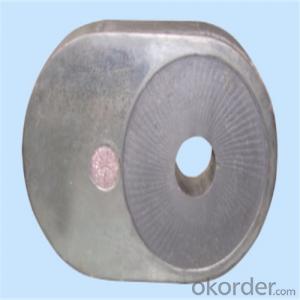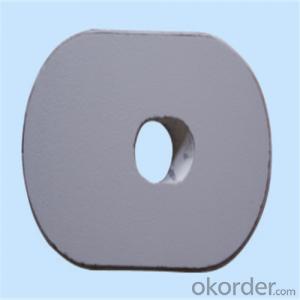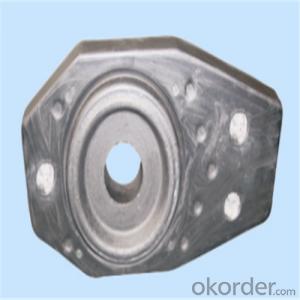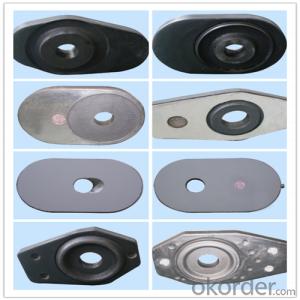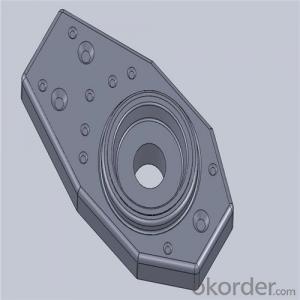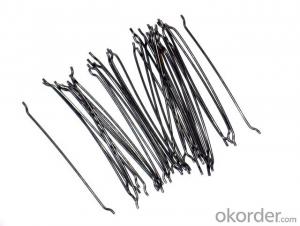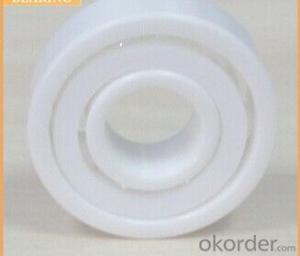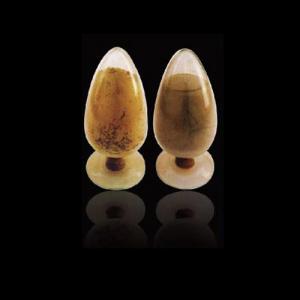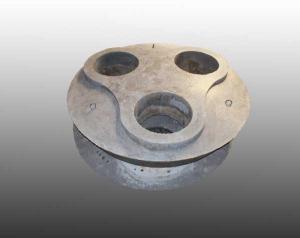High Performance Ladle Slide Gate for Steel Industry 2015
- Loading Port:
- Shanghai
- Payment Terms:
- TT OR LC
- Min Order Qty:
- 100 pc
- Supply Capability:
- 1000 pc/month
OKorder Service Pledge
OKorder Financial Service
You Might Also Like
Quick Details for High Performance Refractory Ladle Slide Gate
| Place of Origin: | China (Mainland) | Shape: | Plate | Material: | Alumina Block |
| SiO2 Content (%): | N/A | Al2O3 Content (%): | 80-90% | MgO Content (%): | N/A |
| CaO Content (%): | N/A | Refractoriness (Degree): | 1770°< Refractoriness< 2000° | CrO Content (%): | N/A |
| SiC Content (%): | N/A | Model Number: | CS80 | Brand Name: | |
| Product name: | High performance refractory ladle slide gate | Model No.: | cs80 | Brand name: | CMAX |
| Quality: | Al-C or Al-Zr-C | Service life: | 4-6 heats | Apparent porosity: | 7% Max |
| Bulk density:: | 3.1 MIN | C.C.S: | 120MPA | MOQ: | 100 pcs for trial |
| Delivery time: | 60 working days upon receipt of deposit |
Packaging & Delivery
| Packaging Details: | Inner carton packing, outer wooden case suitable for long term sea shipping |
| Delivery Detail: | three months working days upon receipt of deposit |
Specifications
Surface flatness less than 0.05mm
High mechanical strength
Erosion resistance
Oxidation resistance
Thermal shock stability
Using the raw materials of tabular alumina, zirconia-corundum, carbon and other high-grade additives, after sintering to obtain characteristics of oxidation resistance, scour strength, erosion resistance, thermal shock resistance, shape stable and long service life, made our products the preferred materials for the large and medium-sized steel ladle, refining ladle, series of alloy steel ladle, and tundish. Our high performance sintering sliding gates include alumina carbon , Al2O3-ZrO2-C, etc, can meet the needs of different steel grade.
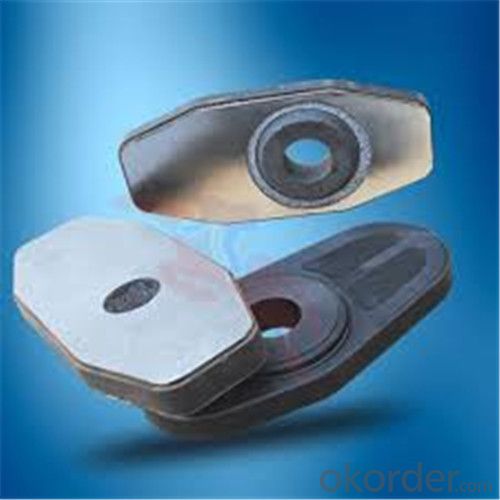
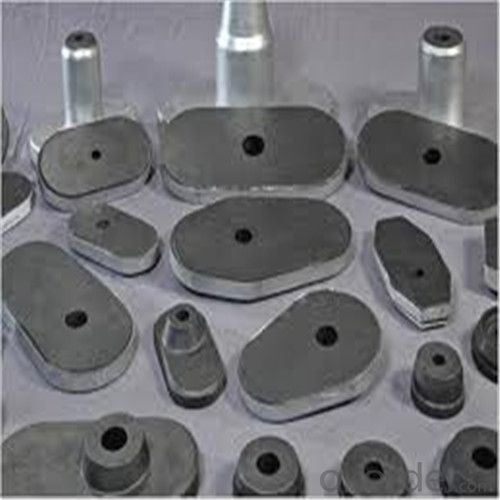

General Chemical Analysis for refractory ladle slide gate :
slide gate plate widely including Alumina carbon and Alumina Zirconia Carbon slide gate plate, MgO and MgO-spinel slide gate plate,nonoxides bonding slide gate plateand unburned slide gate plate.
Alumina -Zirconia-Carbon material
| Al-Zr-C Material | |||||
| Al2O3 | C | ZrO2 | Apparent porosity | Bulk density | C.C.S |
| (% minm) | (% minm) | (% minm) | (% max) | (gm./cc minm) | (MPa minm) |
| 85 | 3 | 5 | 7 | 3.1 | 120 |
| 85 | 3 | 4 | 7 | 3.1 | 120 |
Composite type: Al-Zr-C for working line, outer Al-C material
| Al-Zr-C & Al-C Material | ||||||
| Al2O3 | C | ZrO2 | Apparent porosity | Bulk density | C.C.S | |
| (% minm) | (% minm) | (% minm) | (% max) | (gm./cc minm) | (MPa minm) | |
| Inner side (Working face) | 85 | 3 | 4 | 7 | 3.1 | 120 |
| Outside | 90 | 3 | 0 | 9 | 3 | |
Other Products:
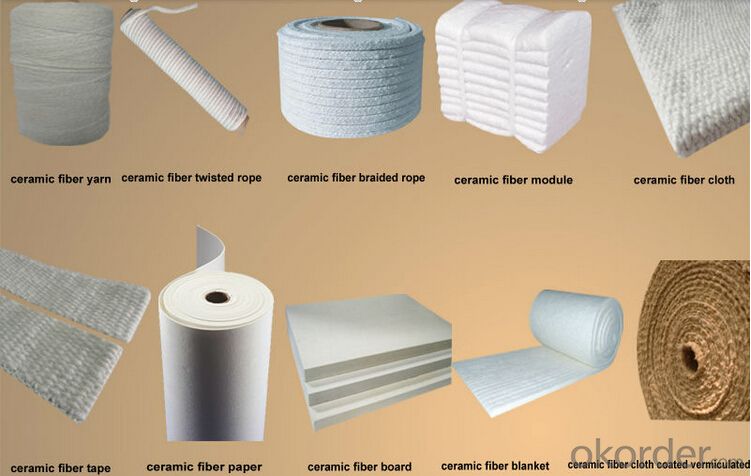
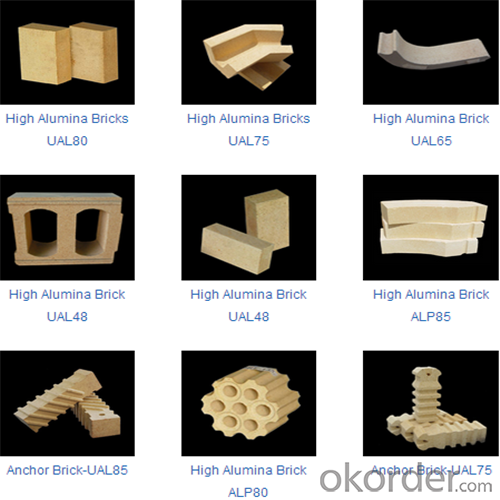
About us

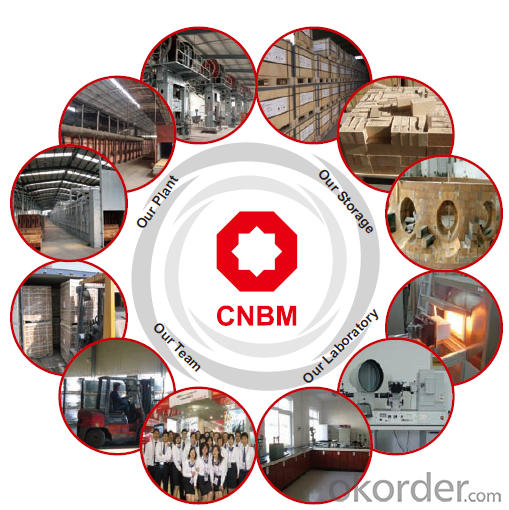
Sample is on your request.
Welcome to visit our factory~
- Q:How do monolithic refractories contribute to the overall efficiency of ladle transfer processes?
- The efficiency of ladle transfer processes is greatly improved by the use of monolithic refractories. These refractories are made from a single, uniform material, making them easy to install and maintain. This feature reduces downtime during ladle transfers, ultimately increasing productivity. One of the ways in which monolithic refractories enhance efficiency is through their high thermal conductivity. Ladle transfers involve the movement of molten metal, which generates a significant amount of heat. Monolithic refractories have exceptional heat resistance, allowing them to withstand the extreme temperatures of the molten metal. This property prevents refractory failure and extends the lifespan of the ladle, resulting in more efficient and uninterrupted ladle transfer operations. Furthermore, monolithic refractories provide superior corrosion resistance. The corrosive nature of molten metal can cause considerable damage to ladles over time. However, monolithic refractories are specifically designed to withstand chemical attacks from molten metal, preventing the degradation of the ladle's integrity. Consequently, ladles lined with monolithic refractories have a longer lifespan and require less frequent replacement, leading to cost savings and improved efficiency. Another factor contributing to the efficiency of ladle transfer processes is the ability of monolithic refractories to conform to complex shapes and designs. Ladles come in various sizes and shapes, and monolithic refractories can be customized to perfectly fit the dimensions of the ladle. This precise fit minimizes heat loss and maximizes energy efficiency during ladle transfers. Additionally, monolithic refractories offer excellent mechanical strength and resistance to thermal shock. Ladle transfer processes involve the handling and movement of ladles, subjecting refractories to mechanical stresses. The exceptional mechanical properties of monolithic refractories ensure their durability and prevent cracking or spalling, reducing the risk of refractory failure and enhancing the efficiency of ladle transfer operations. In conclusion, the efficiency of ladle transfer processes is improved by the use of monolithic refractories due to their high thermal conductivity, corrosion resistance, precise lining fit, and excellent mechanical properties. These refractories enhance the durability of ladles, reduce downtime, and improve energy efficiency, resulting in cost savings and increased productivity in the steelmaking industry.
- Q:What are the main challenges in designing the lining system with monolithic refractories?
- The main challenges in designing the lining system with monolithic refractories include ensuring proper installation and curing, achieving adequate strength and durability, managing thermal expansion and contraction, controlling shrinkage and cracking, and maintaining chemical resistance against corrosive environments. Additionally, the selection of suitable raw materials, proper mixing techniques, and effective installation methods are crucial to overcome these challenges and ensure a successful lining system design.
- Q:What are the typical applications of monolithic refractories in the iron and steel industry?
- Various applications within the iron and steel industry widely utilize monolithic refractories. These refractories, composed of a single material, offer numerous advantages including easy installation, thermal shock resistance, and excellent resistance to chemical attacks. Below are some typical applications of monolithic refractories in the iron and steel industry: 1. Blast Furnace: In blast furnaces, monolithic refractories line the interior and endure extreme temperatures and chemical reactions. They provide thermal insulation, prevent erosion, and resist the corrosive effects of molten iron and slag. 2. Ladles and Tundishes: Monolithic refractories line ladles and tundishes, vessels used for transporting and transferring molten metal. These refractories offer effective thermal insulation and resistance to erosion and chemical attacks, ensuring the integrity of the vessels. 3. Steelmaking Converters: Converters, essential in the steelmaking process to convert molten pig iron into steel, utilize monolithic refractories. These refractories provide protection against high temperatures and aggressive chemical environments encountered during the process. 4. Electric Arc Furnaces (EAF): Monolithic refractories line the walls and roofs of EAFs, used to recycle scrap steel by melting it. These refractories offer outstanding thermal insulation, resistance to slag erosion, and thermal shock resistance, ensuring the longevity and efficiency of the furnace. 5. Continuous Casting: Monolithic refractories find employment in the continuous casting process, where molten steel solidifies into a continuous slab or billet. These refractories line the walls and floors of the casting molds, providing thermal insulation and resistance to chemical attacks from the molten steel. 6. Reheating Furnaces: Monolithic refractories are used in reheating furnaces, which heat steel billets or ingots prior to further processing. These refractories provide insulation, high-temperature resistance, and ensure uniform heating of the metal. Overall, monolithic refractories play a crucial role in the iron and steel industry by providing reliable and durable linings in various applications. Their ability to withstand extreme temperatures, chemical attacks, and thermal shocks makes them indispensable for maintaining the integrity and efficiency of the production processes.
- Q:How do monolithic refractories perform in electric arc furnace roof applications?
- Monolithic refractories are highly effective in electric arc furnace (EAF) roof applications due to their unique properties and characteristics. These refractories, which are composed of a single, solid material, offer several advantages in this specific application. Firstly, monolithic refractories provide excellent thermal insulation, which is crucial in EAF roof applications. The intense heat generated in the furnace can cause structural damage to traditional brick refractories, but monolithic refractories have a higher resistance to thermal shock, reducing the risk of cracking and spalling. This allows them to maintain their integrity and insulation properties even in extreme temperature conditions. Moreover, monolithic refractories have high strength and abrasion resistance, ensuring their durability and longevity in EAF roof applications. The roof of an electric arc furnace is exposed to harsh conditions, including the impact of scrap materials and the erosive effect of molten metal and slag. Monolithic refractories are designed to withstand these challenges, offering superior resistance to mechanical wear and erosion. Another advantage of monolithic refractories is their ease of installation. Unlike traditional brick refractories, which require time-consuming and complex installation processes, monolithic refractories can be applied quickly and efficiently. They can be cast, gunned, or sprayed onto the roof surface, conforming to any shape or contour, thus reducing downtime during installation or repair. Furthermore, monolithic refractories provide increased energy efficiency in EAF roof applications. Their superior insulation properties minimize heat loss, resulting in reduced energy consumption and cost savings. This is particularly important for electric arc furnaces, as they rely on high temperatures to melt and process metals, and any heat loss can significantly impact the efficiency and productivity of the furnace. In conclusion, monolithic refractories are highly suitable for electric arc furnace roof applications due to their exceptional thermal insulation, strength, abrasion resistance, ease of installation, and energy efficiency. These refractories offer significant advantages over traditional brick refractories, ensuring optimal performance and prolonged service life in the demanding environment of an electric arc furnace.
- Q:What are the main factors affecting the thermal expansion of monolithic refractories?
- The main factors affecting the thermal expansion of monolithic refractories include the type of refractory material, the temperature range, the chemical composition, and the physical structure of the refractory. Firstly, the type of refractory material plays a significant role in its thermal expansion behavior. Different types of refractories, such as alumina-based, silica-based, and magnesia-based refractories, have varying coefficients of thermal expansion (CTE). For example, alumina-based refractories generally have a lower CTE compared to silica-based refractories. Therefore, the choice of refractory material can greatly influence its thermal expansion characteristics. Secondly, the temperature range at which the refractory is exposed affects its thermal expansion. As the temperature increases, the refractory material expands due to the thermal energy absorbed. However, different refractories have different temperature-dependent expansion behaviors. Some refractories may have a linear or near-linear expansion with temperature, while others may exhibit non-linear or step-wise expansion. The temperature range of operation is an important consideration in determining the suitability of a refractory for a particular application. The chemical composition of the refractory also affects its thermal expansion. The presence of different chemical elements and compounds in the refractory material can influence its expansion behavior. For example, the addition of certain oxides, such as magnesia or zirconia, can alter the CTE of the refractory. Similarly, impurities or variations in the chemical composition can introduce differences in expansion characteristics among refractories of the same type. Lastly, the physical structure of the refractory, including its porosity, density, and microstructure, can affect thermal expansion. The presence of open or closed pores within the refractory can affect its ability to expand uniformly under thermal stress. The density of the refractory also plays a role, as denser refractories tend to have lower thermal expansion. Additionally, the microstructure, including grain size and orientation, can influence the overall expansion behavior of the refractory. In conclusion, the main factors affecting the thermal expansion of monolithic refractories include the type of refractory material, temperature range, chemical composition, and physical structure. Understanding these factors is essential in selecting the appropriate refractory for a specific application to ensure optimal performance and durability.
- Q:How do monolithic refractories perform in rotary kiln applications?
- Monolithic refractories perform exceptionally well in rotary kiln applications due to their high thermal shock resistance, excellent chemical resistance, and superior strength at high temperatures. Their ability to withstand extreme heat and harsh chemical environments makes them ideal for lining the interior of rotary kilns. Additionally, monolithic refractories offer easy installation and maintenance, ensuring efficient and reliable kiln operations.
- Q:How are monolithic refractories repaired or replaced in iron and steel facilities?
- Due to their superior thermal and mechanical properties, monolithic refractories are widely used in iron and steel facilities. These refractories are designed to withstand high temperatures, thermal shocks, and chemical attacks. However, over time, they may experience wear and tear, leading to the need for repair or replacement. The process of repairing or replacing monolithic refractories in iron and steel facilities typically involves the following steps: 1. Inspection: A comprehensive inspection is performed to identify areas that require repair or replacement. This inspection may include visual examination, thermal imaging, or other non-destructive testing techniques to assess the extent of damage. 2. Removal of damaged material: The damaged monolithic refractory material is carefully extracted using appropriate tools and equipment. This step ensures proper adhesion of the new refractory material to the substrate. 3. Surface preparation: The substrate or lining surface is prepared to improve the bonding between the new refractory material and the existing structure. This may involve cleaning, grinding, or shot blasting to remove loose particles, contaminants, and any remaining damaged material. 4. Selection of repair material: Depending on specific requirements and operating conditions, a suitable repair material is chosen. This may involve selecting a similar monolithic refractory material or a specialized repair product designed for the application. 5. Mixing and installation: The repair material is mixed according to the manufacturer's instructions, ensuring the right consistency and workability. It is then applied to the prepared surface using various techniques such as troweling, spraying, or casting. Attention is given to achieve the desired thickness and proper consolidation of the repair material. 6. Curing and drying: After installation, the repaired refractory material is allowed to cure and dry according to the manufacturer's recommendations. This step is crucial to achieve the desired strength and thermal properties of the refractory lining. 7. Quality control: Once the repair or replacement is complete, quality control measures are implemented to ensure the integrity and effectiveness of the repaired or refurbished refractory lining. This may involve conducting tests such as thermal conductivity measurements, density checks, or visual inspections. It is important to note that the process of repairing or replacing monolithic refractories may vary depending on the specific requirements and conditions of each iron and steel facility. Additionally, it is advisable to consult with refractory experts or manufacturers to ensure the correct selection of materials and proper execution of the repair or replacement procedure.
- Q:What are the recommended curing and drying procedures for monolithic refractories?
- The recommended curing and drying procedures for monolithic refractories depend on the specific type and composition of the refractory material. However, there are some general guidelines that can be followed. Curing refers to the process of allowing the refractory material to set and harden. This is typically done by exposing the material to a controlled temperature and humidity environment. The curing process helps to develop the desired physical and chemical properties of the refractory, such as strength and resistance to thermal shock. Drying, on the other hand, refers to the removal of moisture from the refractory material. This is important because moisture can cause the refractory to crack or spall when exposed to high temperatures. Drying is typically done after the curing process. The curing and drying procedures for monolithic refractories often involve the following steps: 1. Preheating: Before applying the refractory material, it is important to preheat the surface to which it will be applied. This helps to prevent rapid moisture evaporation and ensures good adhesion of the refractory. 2. Mixing and application: The refractory material should be mixed according to the manufacturer's instructions and applied to the desired surface using appropriate techniques such as gunning, casting, or ramming. 3. Initial curing: After application, the refractory should be allowed to cure at a controlled temperature and humidity for a specific duration. This allows the material to set and develop its strength. The curing temperature and duration may vary depending on the specific refractory material, but it is typically recommended to start with a lower temperature and gradually increase it over time. 4. Drying: Once the initial curing is complete, the refractory should be dried to remove any remaining moisture. This is typically done by gradually increasing the temperature in a controlled manner. The drying temperature and duration may vary depending on the specific refractory material, but it is important to avoid rapid temperature changes to prevent thermal stress and cracking. 5. Final curing: After drying, the refractory should be allowed to cool down gradually to room temperature. This final curing step helps to further develop the refractory's strength and stability. It is crucial to follow the manufacturer's guidelines and recommendations for the specific refractory material being used, as different materials may have different curing and drying requirements. Additionally, factors such as the size and shape of the refractory installation, as well as the surrounding environment, may also influence the curing and drying procedures. Consulting with a refractory specialist or manufacturer is always recommended to ensure the proper curing and drying procedures are followed for optimal performance and longevity of the monolithic refractories.
- Q:What are the challenges in recycling and disposing of monolithic refractories?
- One challenge in recycling and disposing of monolithic refractories is the high temperature resistance and durability of these materials, which makes them difficult to break down and recycle. Additionally, the presence of various contaminants, such as metals and other impurities, can further complicate the recycling process. Proper disposal of monolithic refractories also poses challenges due to the potential environmental impact of disposing of these materials, as they may contain hazardous substances. Therefore, finding efficient and environmentally-friendly methods for recycling and disposing of monolithic refractories remains a challenge in the industry.
- Q:What are monolithic refractories and how are they different from other refractory materials?
- Monolithic refractories, unlike bricks or tiles, are refractory materials that are not pre-formed into specific shapes or sizes. Instead, they are composed of a mixture of aggregates, binders, and additives, which are then installed and cured to create a solid and dense structure. One notable difference between monolithic refractories and other refractory materials is their versatility and ease of installation. While traditional bricks or tiles require skilled labor and careful assembly, monolithic refractories can be poured, sprayed, or gunned into place, allowing for a faster and more efficient installation process. This makes them particularly suitable for complex shapes or hard-to-reach areas. Another distinction lies in the physical properties of monolithic refractories. Unlike bricks and tiles, which are known for their mechanical strength and resistance to thermal shock, monolithic refractories can be customized to exhibit a wide range of properties. Depending on the specific application requirements, they can be engineered to have excellent thermal insulation, superior corrosion resistance, or enhanced abrasion resistance. This adaptability makes monolithic refractories suitable for various industries, including steel, cement, glass, and petrochemical. Furthermore, monolithic refractories have the advantage of being able to expand and contract with temperature changes, unlike rigid brick structures. This thermal flexibility helps prevent cracking and damage caused by thermal cycling, thus prolonging the lifespan of the refractory lining. Additionally, monolithic refractories offer better refractory integrity and reduced joint failure since they do not have seams or weak points that are susceptible to thermal stresses. In conclusion, monolithic refractories are a versatile and convenient type of refractory material that can be tailored to meet specific application requirements. Their easy installation, thermal flexibility, and customizable properties distinguish them from other refractory materials like bricks or tiles.
1. Manufacturer Overview |
|
|---|---|
| Location | |
| Year Established | |
| Annual Output Value | |
| Main Markets | |
| Company Certifications | |
2. Manufacturer Certificates |
|
|---|---|
| a) Certification Name | |
| Range | |
| Reference | |
| Validity Period | |
3. Manufacturer Capability |
|
|---|---|
| a)Trade Capacity | |
| Nearest Port | |
| Export Percentage | |
| No.of Employees in Trade Department | |
| Language Spoken: | |
| b)Factory Information | |
| Factory Size: | |
| No. of Production Lines | |
| Contract Manufacturing | |
| Product Price Range | |
Send your message to us
High Performance Ladle Slide Gate for Steel Industry 2015
- Loading Port:
- Shanghai
- Payment Terms:
- TT OR LC
- Min Order Qty:
- 100 pc
- Supply Capability:
- 1000 pc/month
OKorder Service Pledge
OKorder Financial Service
Similar products
New products
Hot products
Hot Searches
Related keywords
